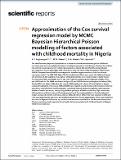Files in this item
Approximation of the Cox survival regression model by MCMC Bayesian hierarchical Poisson modelling of factors associated with childhood mortality in Nigeria
Item metadata
| dc.contributor.author | Fagbamigbe, A F | |
| dc.contributor.author | Salawu, M M | |
| dc.contributor.author | Abatan, S M | |
| dc.contributor.author | Ajumobi, O | |
| dc.date.accessioned | 2021-07-07T13:30:15Z | |
| dc.date.available | 2021-07-07T13:30:15Z | |
| dc.date.issued | 2021-06-29 | |
| dc.identifier | 274947192 | |
| dc.identifier | afaa1119-b960-43e3-a9ce-ba0466a9a970 | |
| dc.identifier | 000671782600010 | |
| dc.identifier | 85108999404 | |
| dc.identifier.citation | Fagbamigbe , A F , Salawu , M M , Abatan , S M & Ajumobi , O 2021 , ' Approximation of the Cox survival regression model by MCMC Bayesian hierarchical Poisson modelling of factors associated with childhood mortality in Nigeria ' , Scientific Reports , vol. 11 , 13497 . https://doi.org/10.1038/s41598-021-92606-0 | en |
| dc.identifier.issn | 2045-2322 | |
| dc.identifier.other | RIS: urn:C5A1ED8FC3DB8A685D59E61EC68FEF60 | |
| dc.identifier.uri | https://hdl.handle.net/10023/23481 | |
| dc.description.abstract | The need for more pragmatic approaches to achieve sustainable development goal on childhood mortality reduction necessitated this study. Simultaneous study of the influence of where the children live and the censoring nature of children survival data is scarce. We identified the compositional and contextual factors associated with under-five (U5M) and infant (INM) mortality in Nigeria from 5 MCMC Bayesian hierarchical Poisson regression models as approximations of the Cox survival regression model. The 2018 DHS data of 33,924 under-five children were used. Life table techniques and the Mlwin 3.05 module for the analysis of hierarchical data were implemented in Stata Version 16. The overall INM rate (INMR) was 70 per 1000 livebirths compared with U5M rate (U5MR) of 131 per 1000 livebirth. The INMR was lowest in Ogun (17 per 1000 live births) and highest in Kaduna (106), Gombe (112) and Kebbi (116) while the lowest U5MR was found in Ogun (29) and highest in Jigawa (212) and Kebbi (248). The risks of INM and U5M were highest among children with none/low maternal education, multiple births, low birthweight, short birth interval, poorer households, when spouses decide on healthcare access, having a big problem getting to a healthcare facility, high community illiteracy level, and from states with a high proportion of the rural population in the fully adjusted model. Compared with the null model, 81% vs 13% and 59% vs 35% of the total variation in INM and U5M were explained by the state- and neighbourhood-level factors respectively. Infant- and under-five mortality in Nigeria is influenced by compositional and contextual factors. The Bayesian hierarchical Poisson regression model used in estimating the factors associated with childhood deaths in Nigeria fitted the survival data. | |
| dc.format.extent | 18 | |
| dc.format.extent | 3609899 | |
| dc.language.iso | eng | |
| dc.relation.ispartof | Scientific Reports | en |
| dc.subject | Epidemiology | en |
| dc.subject | Health care | en |
| dc.subject | Risk factors | en |
| dc.subject | Statistics | en |
| dc.subject | HA Statistics | en |
| dc.subject | RA Public aspects of medicine | en |
| dc.subject | 3rd-DAS | en |
| dc.subject.lcc | HA | en |
| dc.subject.lcc | RA | en |
| dc.title | Approximation of the Cox survival regression model by MCMC Bayesian hierarchical Poisson modelling of factors associated with childhood mortality in Nigeria | en |
| dc.type | Journal article | en |
| dc.contributor.institution | University of St Andrews. Population and Behavioural Science Division | en |
| dc.contributor.institution | University of St Andrews. School of Medicine | en |
| dc.identifier.doi | https://doi.org/10.1038/s41598-021-92606-0 | |
| dc.description.status | Peer reviewed | en |
This item appears in the following Collection(s)
Items in the St Andrews Research Repository are protected by copyright, with all rights reserved, unless otherwise indicated.

